Syncfusion® Utilities
4 Dec 202520 minutes to read
Syncfusion® provides various utilities to configure and control the default configured items during the installation. Find below some of the major utilities and its usage in detail.
Syncfusion® Control Panel
This section describes the structure and components of the Syncfusion® Control Panel. It also goes over how to use the Syncfusion® Control Panel to gain access to various utilities, add-ons, and product samples.
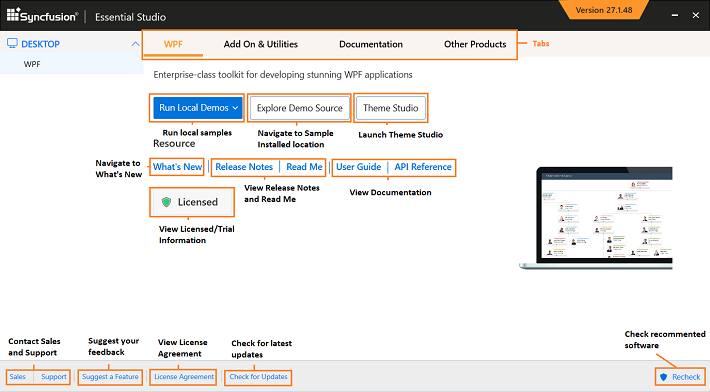
Accessing Product Samples
Syncfusion® provides online and local demos for better understanding of the controls. You can access to them by following the steps below.
-
Open the Syncfusion® Control Panel.
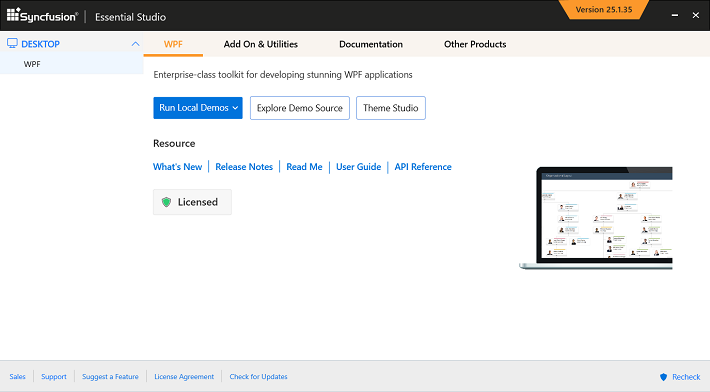
-
Click any of the following to know more about the selected product.
- Run Local Demos - To run the locally installed samples.
- Run Online Demos - To view online samples.
- Explore Demos - To open local installed location.
- Explore Source - To view the source, when you have installed the source add-on.
- User Guide - To view the user guide documentation for the respective products.
- API Reference - To view the online documentation help contents for the respective products.
- Release Notes - To view the “Release Notes” content.
- Read Me - To view the “Read Me” content.
- What’s New - To view the “What’s New” content.
Checking Prerequisites
You need to install a list of prerequisites, for all of the products to work successfully. When some of the software is not installed, the Syncfusion® Control Panel displays an alert. Click Additional Software Required, and a Missing Software dialog box opens.
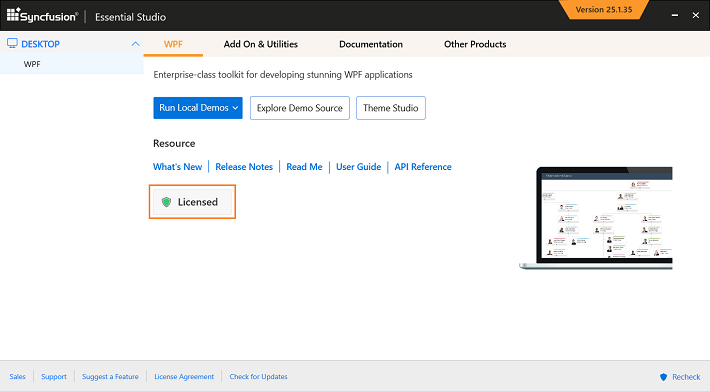
Missing Software
Missing Software lists the prerequisites for all platforms. A  Additional Software Required
Additional Software Required
symbol appears when any recommended software for a platform is not installed in your system.
The Recheck option rechecks the prerequisites list and refreshes the currently installed software list.
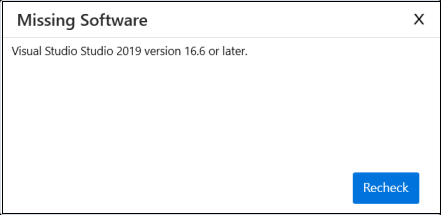
Purpose of Recheck button
The Recheck option rechecks the prerequisites list and refreshes the currently installed software list
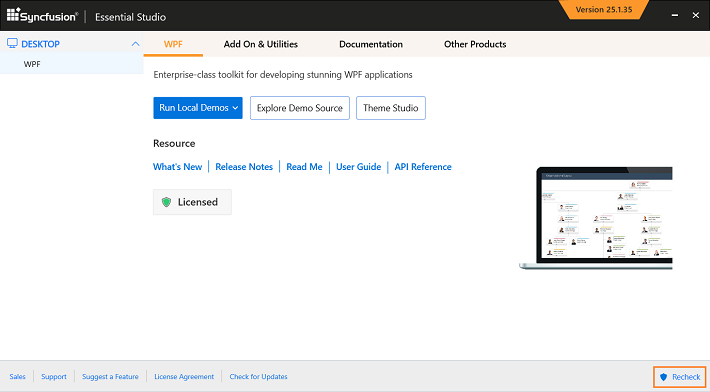
Accessing utilities from Syncfusion® Control Panel
This section allows you to access the following.
-
Add-ons - This lists the add-on utilities that help you to utilize the additional product services from Syncfusion®.
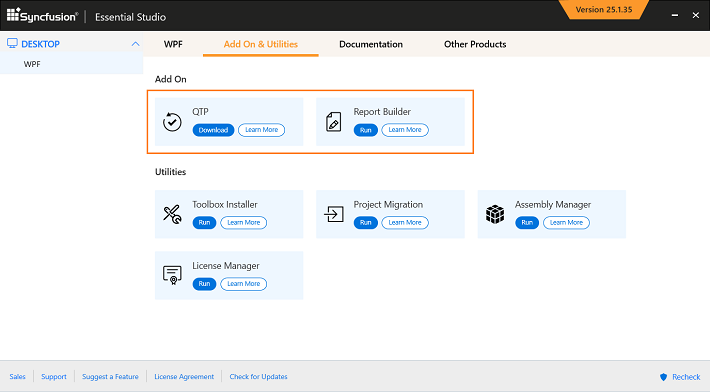
-
Utilities - This section displays the utilities that are available for the corresponding product.
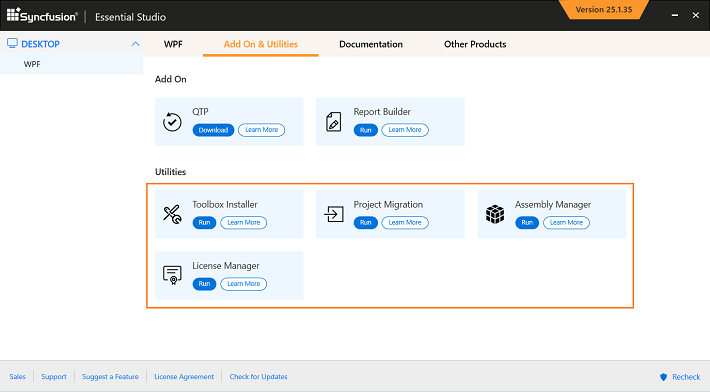
- Toolbox Configuration- This installer allows you to configure Syncfusion® controls for various .NET Frameworks in combination with compatible Visual Studio versions.
- Assembly Manager- This utility allows you to manage installing or uninstalling Syncfusion® Essential Studio® assemblies in the GAC and in the Assemblies folders.
- License Manager- This allows you to manage the license information, such as the validity of license key and products that are licensed with this key.
- Project Migration- This allows to migrate the project references to the given Essential Studio® version.
License Information
You can view your license details in the Syncfusion® Control Panel. License information which includes, whether the setup is installed with Licensed or Trial. Syncfusion® Trial expires in 30 days.
-
Messages- This section allows you to view the License information, like whether the user is Licensed or Trial. Syncfusion® Trial expires in 30 days.

General resources
- Sales FAQ - Clicking this link directs you to the FAQ page that lists common sales-related queries and other sales contact information.
- Contact Support - Clicking this link directs you to the Direct-Trac Login page to contact the Support Team.
- Check for updates - Shows the latest version of Syncfusion® Essential Studio® if available.
- License Agreement - Shows the License Agreement for the current version of Essential Studio®.
Documentation
You can access the respective products user guide, online and offline class reference documents from here.

User Guide
PDF Download – Downloads the respective product and versions user guide documents in PDF format.
View on Web – You can also view the online user guide documents on clicking this button
API Reference
- Visual Studio Help Viewer – You can download the offline class reference document and integrate it your Visual Studio Help Viewer
- View on Web – You can also view the online API Class Reference document for the respective product and version.
Other products
You can also get a quick glimpse of our other available products here, download, and install it and have a try.
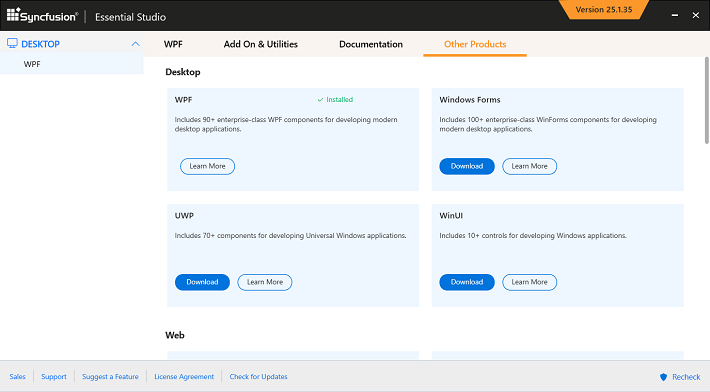
If you have installed any other products in the same version, then you can open the respective products Syncfusion® Control Panel from here too.
Assembly Manager
The Assembly Manager is used to install and uninstall the assemblies, to and from the GAC and Public Assemblies folder under the installed location.
Supported Platforms
Assembly Manager will be shipped for the following platforms as these platforms alone have the GAC support. Other Syncfusion® platform assemblies will not be installed in GAC and the Assembly Manager will not be shipped.
- WPF
- Windows Forms
- FileFormats
Launching the Assembly Manager
Use the following steps to run the Assembly Manager.
- Open Syncfusion® Control Panel.
-
Click Add On and Utilities > Assembly Manager.
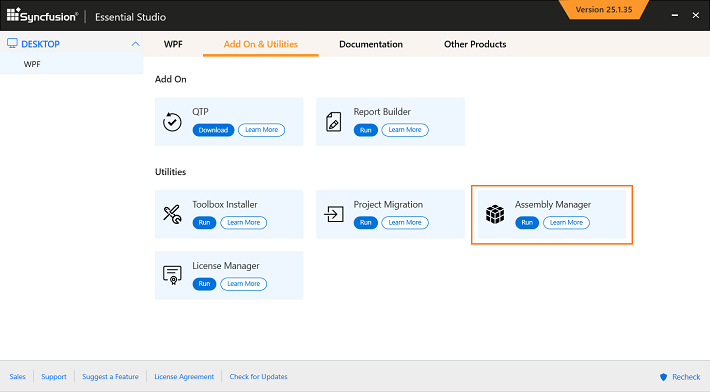
- The Syncfusion® {platform} Assembly Manager x.x.x window opens.
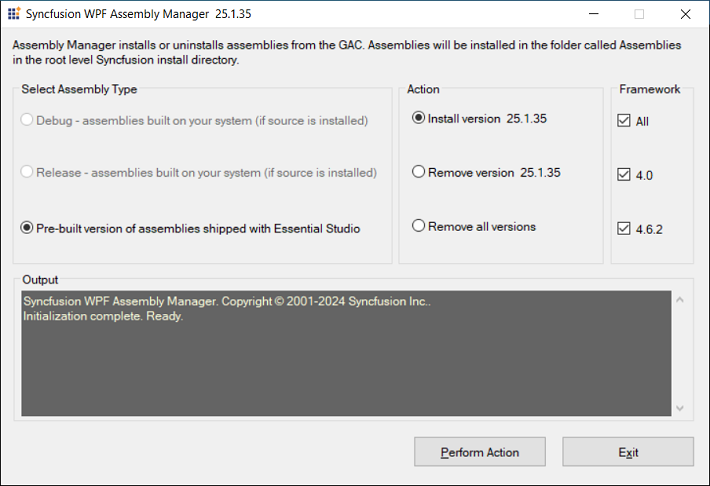
-
Select the required option from Select Assembly Type.
- Pre-built Assemblies - These are the assemblies shipped with Essential Studio®. Selecting this mode triggers the Assembly Manager to install the pre-built assemblies.
-
Select the required option for the Action sections.
Action
The Assembly Manager can install or uninstall assemblies. To perform this action, select the Install version x.x.x or Remove version x.x.x radio button. To remove all, select the Remove all versions radio button.
NOTE
Remove All Versions must be used with caution in scenarios when one has applications depending on certain versions of the Syncfusion® assemblies installed in the GAC. They may cease to function.
-
Select the required option for Framework sections.
Framework
The Framework group box comprises of check boxes for the .NET Framework versions based on the Visual Studio SDK installed in the machine. The following check boxes are available:
- 4.6.2 - Selecting 4.6.2 ensures installation of 4.6.2 assemblies into the GAC and assemblies folder. In cases where only Visual Studio 2017 SDK is installed, the 4.6.2 assemblies have to be deployed.
NOTE
- From 2018 Volume 4, Syncfusion® has removed the .NET Framework 4.5.1 and MVC3 assemblies from installer. Refer to this topic to enable 4.5.1 checkboxes.
- By default 2.0 is enabled in a system where Visual Studio 2008 SDK is installed.
- From 2024 Volume 4, Syncfusion® has removed the .NET Framework 4.0 from installer.
-
Click Perform Action. It starts processing.
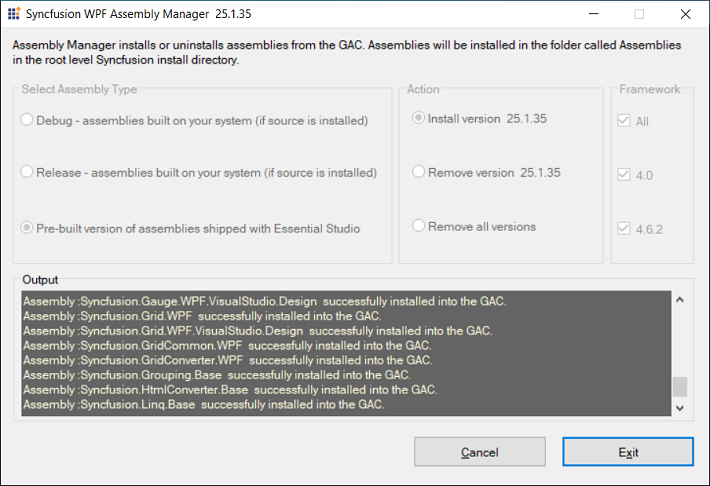
-
Once the action is completed, a confirmation message is displayed.
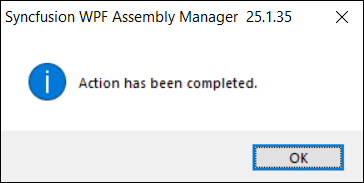
-
Click OK.
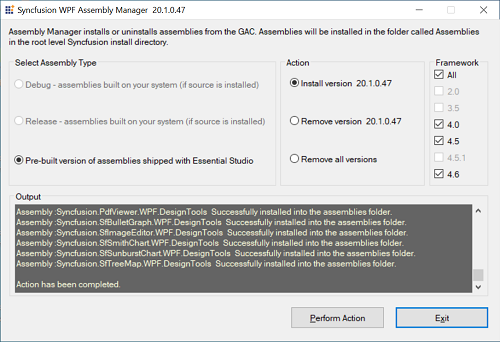
The libraries under the Assemblies folder get installed in your GAC during the runtime of Assembly Manager utility.
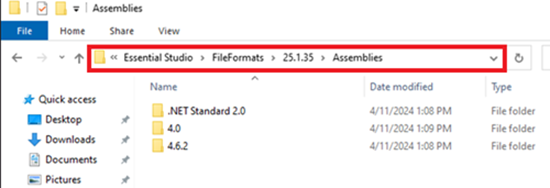
-
When you add a reference to a Syncfusion® assembly in your project, link to the one under the Assemblies directory and set the “Copy Local” setting to be False (which is the case by default). With this setting, when you run the corresponding built .exe, it will load the corresponding Syncfusion® library in the GAC. This is the recommended model for linking to our libraries.
-
Visual Studio automatically detects the version of the Syncfusion® assemblies that are in the Assemblies folder. This means that if you want to manually add a reference in your project for example, you can select the assembly directly from the “.NET” tab in the “Add Reference” dialog.
-
GAC-supported Platforms assemblies will be available in the “Syncfusion\Essential Studio(Platform Type)(Version)\Assemblies” folder. If you need any other framework, you can refer to it from the “Syncfusion\Essential Studio(Platform Type)(Version)\precompiledassemblies” folder for your project.
-
License Manager
The License Manager helps to manage unlock key information, such as the validity of a Syncfusion® unlock key used in your system.
NOTE
- License Manager is used only to view the license information, adding\removing the unlock key.
- Syncfusion® License key should not be used here. Refer this KB article to know more about the difference between the Syncfusion® Unlock Key and the Syncfusion® License Key
Launching License Manager
Follow the steps provided to launch the License Manager from the Dashboard.
- Open the Syncfusion® Control Panel.
- Click Add On and Utilities->License Manager.
-
The Syncfusion® License Manager dialog box opens.
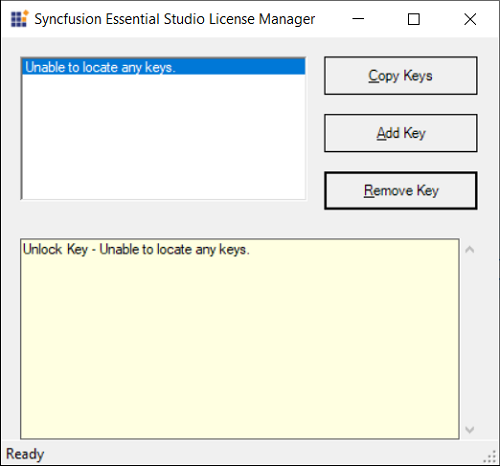
Adding a Product Key
The following are the steps to add a product key.
-
Open the Syncfusion® License Manager Dialog box.
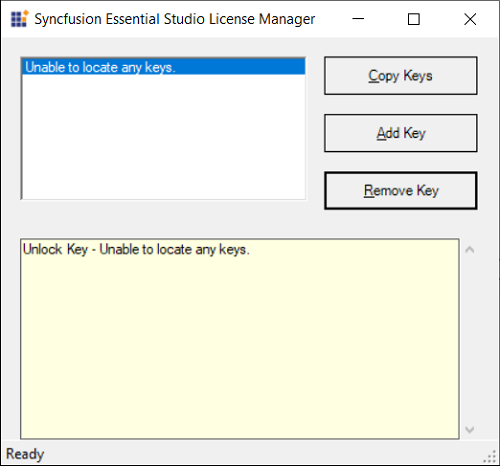
-
Click Add Key. The following dialog box opens.

-
Enter the license key of the product in the space provided.
-
Click OK. The entered key is displayed in the log.
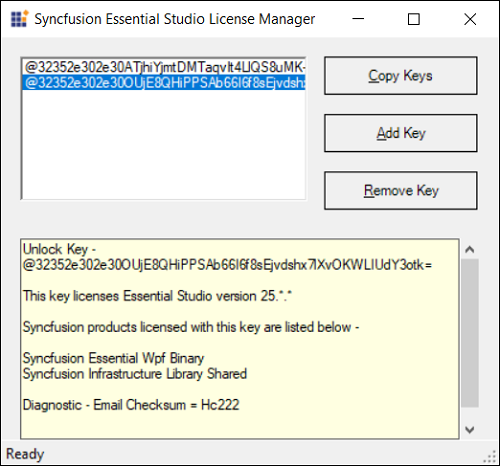
By adding an additional product key, you can also:
- Extend evaluation period. This is applicable for evaluation versions of EssentialStudio®.
- Unlock additional products.
Removing a Product Key
This option allows you to remove a product key from the License Manager window. It allows you to remove an incorrectly added or old license key.
The following are the steps to remove a license key:
- Open the Syncfusion® License Manager dialog box.
-
Select the key to be removed. The selected key is highlighted.
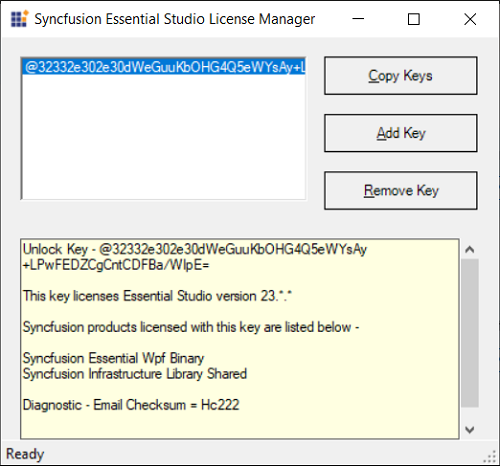
-
Click Remove Key. The selected key is removed.
NOTE
The removal is reflected in the log, when the product key has already been added.
Copying a Product Key
You can copy the product key from the License Manager window to the clipboard. The following are the steps to copy the license key.
- Open the Syncfusion® License Manager Dialog box.
- Select the required key to be copied. The selected key is highlighted.
- Click Copy Key. The selected key is copied. You can paste the key in the required place.
Toolbox Configuration
Syncfusion® provides toolbox support for WPF, Windows Forms, ASP.NET Web Forms, UWP, Xamarin, PDF Viewer SDK, Spreadsheet Editor SDK and DOCX Editor SDK platforms. The Syncfusion® Toolbox Installer utility adds the Syncfusion® controls into the Visual Studio .NET toolbox.
NOTE
- From 2022 Volume 4 SP release, Syncfusion® officially marked the EJ1 product as retired.
- Toolbox configuration support is not available for the Visual Studio Express Edition. However, you can manually configure the Syncfusion® controls into the Visual Studio Express Toolbox. To do so, refer the Manual Toolbox Configuration .
Configuring Toolbox
For Xamarin:
To configure the Syncfusion® Xamarin controls to the Visual Studio toolbox, refer this link.
IMPORTANT
Syncfusion® has started providing Toolbox support for Xamarin platform from v16.2.0.41
For UWP:
Syncfusion® UWP controls will be automatically configured in Visual Studio toolbox while installing the Syncfusion® UWP installer.
For WPF, Windows Forms and ASP.NET Web Forms platforms:
Syncfusion® controls will be automatically configured in the Visual Studio toolbox, while installing the Syncfusion® installer, if the “Configure Syncfusion® Controls in Visual Studio” checkbox is selected from installer UI.
To launch Toolbox configuration utility, follow the steps given below:
-
Open the Syncfusion® Control Panel, click Add On and Utilities > Toolbox Installer.
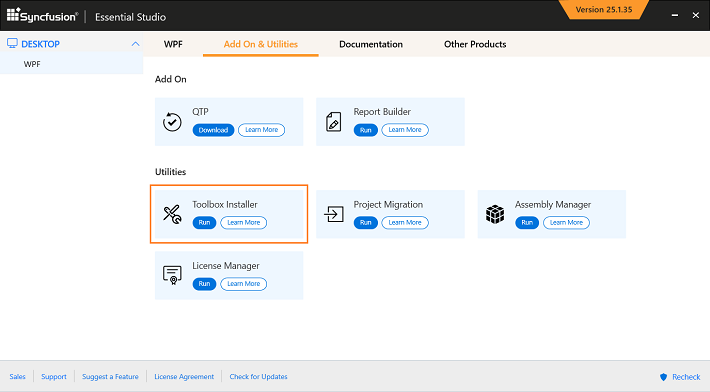
-
Toolbox Installer will be opened.
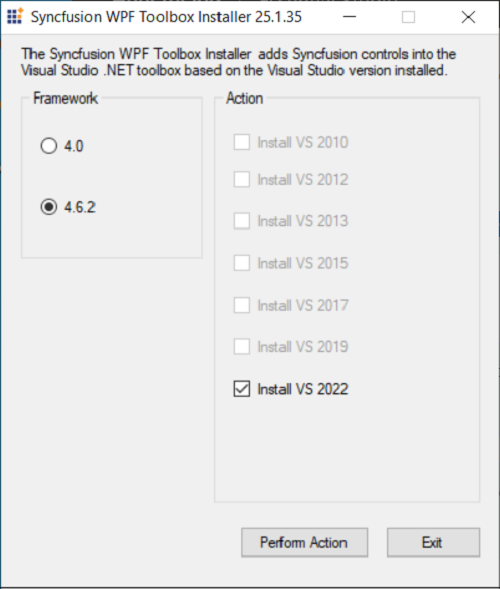
The following options are available in Toolbox Configuration:
- Install VS2015 – Configures Framework 4.6.2 Syncfusion® controls in VS 2015 toolbox.
- Install VS2017 – Configures Framework 4.6.2 Syncfusion® controls in VS 2017 toolbox.
- Install VS2019 – Configures Framework 4.6.2 Syncfusion® controls in VS 2019 toolbox.
- Install VS2022 – Configures Framework 4.6.2 Syncfusion® controls in VS 2022 toolbox.
- Install VS2026 – Configures Framework 4.6.2 Syncfusion® controls in VS 2026 toolbox.
NOTE
You can also configure Syncfusion® controls from a lower version Framework assembly to higher version of Visual Studio.
-
An Information message is displayed indicating the successful configuration of Toolbox. Click OK.
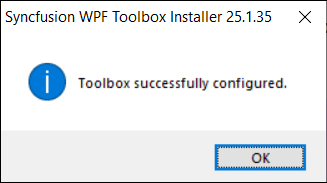
NOTE
- If your installed controls are not reflected properly in the Visual Studio Toolbox, you’ll have to reset the Toolbox.
- This tool configures only the controls that are located under {Installed Location}\Assemblies{Framework version}.
Configuring toolbox in Visual Studio 2026
From 2025 Volume 3 SP 2 Release, Syncfusion® started providing toolbox support for .NET Framework and .NET 8.0\9.0\10.0 in Visual Studio 2026 Toolbox. After installing the Syncfusion® product installer, Syncfusion® controls will be automatically configured in the Visual Studio 2026 toolbox for WPF, Windows projects.
Configuring toolbox in Visual Studio 2022
From 2021 Volume 3, Syncfusion® started providing toolbox support for .NET Framework and .NET 5.0\6.0 in Visual Studio 2022 Toolbox. After installing the Syncfusion® product installer, Syncfusion® controls will be automatically configured in the Visual Studio 2022 toolbox for WPF, Windows, and ASP.NET Web Forms projects.
NOTE
- Syncfusion® WPF .NET 5.0 controls will be compatible with .NET 6.0, on installing the Syncfusion® WPF installer, our .NET 5.0 controls will be configured the toolbox for .NET 6.0 projects too.
- Syncfusion® only supports ASP.NET Web Forms Toolbox in .NET Frameworks.
- From 2022 Volume 4 SP release, Syncfusion® officially marked the EJ1 product as retired.
Configuring toolbox for WPF .NET 8.0\9.0\10.0 projects
From 2025 Volume 3 SP 2 Release, Syncfusion® started providing toolbox support for WPF .NET 8.0\9.0\10.0 framework in Visual Studio 2026. Syncfusion® controls will be automatically configured in the Visual Studio 2026 toolbox for WPF .NET 8.0\9.0\10.0 project, after installing the Syncfusion® WPF, PDF Viewer SDK, Spreadsheet Editor SDK and DOCX Editor SDK installer.
Configuring toolbox for WPF .NET 5.0\6.0 projects
From 2021 Volume 1, Syncfusion® started providing toolbox support for WPF .NET 5.0 framework in Visual Studio 2019. Syncfusion® controls will be automatically configured in the Visual Studio 2019 toolbox for WPF .NET 5.0 project, after installing the Syncfusion® WPF installer.
NOTE
- Syncfusion® included this toolbox support for .NET 5.0 WPF platform from 2021 Volume 1 release version v19.1.0.54 only.
- After installing the WPF setup, if the project created with TargetFramework .NET Core 3.1 and changed to .NET 5.0, you need to restart Visual Studio to get the Syncfusion® controls in Visual Studio Toolbox.
- Visual Studio 2019 16.7 Preview 2 and later is required.
Configuring toolbox for Windows Forms .NET 5.0\6.0 projects from NuGet packages
From 2021 Volume 3, Syncfusion® started providing toolbox support for Windows Forms .NET 5.0\6.0 projects. Please install the respective Syncfusion® WinForms NuGet packages in .NET 5.0\6.0 project to get the Syncfusion® WinForms controls in the .NET 5.0\6.0 Toolbox. After installing the NuGet packages, our WinForms controls will be populated in the Visual Studio toolbox for .NET 5.0\6.0 WinForms project.
Refer this documentation link to find Syncfusion® WinForms nuget packages for the appropriate controls.
Configuring toolbox for .NET Core 3.1 projects
To configure the Syncfusion® toolbox in the WPF .NET Core application, the Syncfusion® NuGet packages should be installed in the .NET Core application. After installing the Syncfusion® NuGet packages in .NET Core application, the corresponding NuGet packages Syncfusion® components will be configured in Visual Studio toolbox.
Multi-Target Manager
Multi-Target Manager helps to manage multiple .NET Frameworks in your Visual Studio 2008 project that is, switching between multiple Frameworks.
NOTE
This is not essential® for VS 2010 because Common Language Runtime (CLR) differs for both 3.5 and 4.0 Frameworks. VS 2010 selects the required .NET Framework assembly for the corresponding projects. 3.5 and 4.0 are the only Frameworks configured; the MultiTarget Manager utility allows you to work on Framework 2.0 with VS 2010.
When to Use Multi-Target Manager?
When Essential Studio® is installed in a machine comprising both 2.0 and 3.5 Frameworks, then, by default, the target Framework is set to 3.5, and the following registry entry AssemblyFoldersEx is also set to 3.5 assembly. You can use the Multi-Target Manager to change the target Framework to 2.0.
Registry Location: HKLM\Software\Microsoft.NetFramework\v3.5\AssemblyFoldersEx\Syncfusion Essential® {platform} 3.5
Launching MultiTarget Manager
-
Open the Multi-Target Manager from below location
Location:{Installed location}\Syncfusion\Essential Studio\{platform}\x.x.x\Utilities\MultiTargetManager\MultiTargetManager.exe -
The Essential Studio® Multi-Target Manager x.x.x dialog box opens.

-
Select the required version from the drop-down list. The Multi-Target Manager dialog box opens.
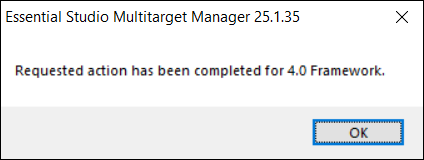
-
Click OK.
-
Open an application.
-
Refresh the application before building.
NOTE
The target value and the registry value change according to the selected Framework version.
Project Migration
For Desktop platforms
The Project Migration tool helps to upgrade the projects to the given Syncfusion® Essential Studio® Version.
Syncfusion® Project Migration tool supports from, Syncfusion® Essential Studio® Version 3.2.1.0 to the latest version and the supported platforms are Windows Forms, WPF and Universal Windows Platform.
NOTE
Project Migration utility will change the Visual Studio Target Framework version and Syncfusion® assembly version alone in the .csproj files.
The following steps illustrate how to migrate a project.
-
Open the Project Migration Tool from the following location.
Location: {Installed location}\Syncfusion\Essential Studio\{Platform}\x.x.x\Utilities\Project Migration\ProjectMigrationWindows.exe.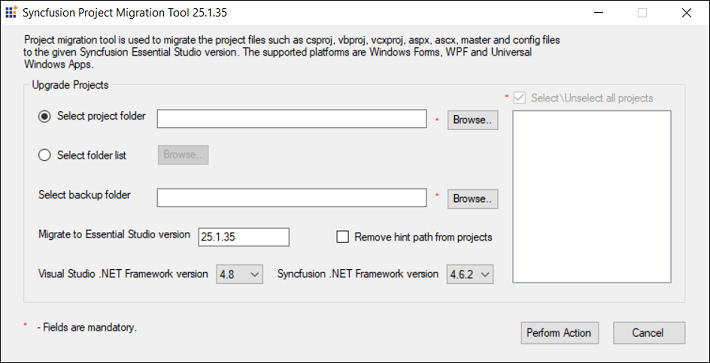
-
Select the project to be upgraded in the Select Project Folder field.
If you have multiple projects in the same folder, you can select/deselect the projects of your choice. You can also select multiple projects location by using the Select Folder List option.
-
Select a folder to store a backup in the Select backup folder field.
-
By default, corresponding Essential Studio® version will be displayed in the Migrate to Essential Studio® Version field.
-
Select the required Visual Studio .NET Framework version and Syncfusion® .NET Framework version from the respective drop-down list.
-
When you refer the Syncfusion® assemblies from Hint path instead of GAC location then, copy the latest assemblies to that location manually or select the Remove hint path from projects check box, to remove the hint from the project. If you are migrating UWP project and you are using the UWP assemblies in your projects instead of SDK, don’t enable the Remove hint path from projects option.
If you have referred the Syncfusion® assemblies to your project from hint path and you have selected the Remove hint path from projects check box in Project Migration utility, Syncfusion® assemblies will be referred from GAC for Windows Forms and WPF platforms if the assemblies are installed in GAC
-
Click Perform Action. The utility upgrades the selected projects to the newer version.
Command Line
The following steps illustrate how to run the Project Migration tool through command line.
-
Open the Command Prompt in administrator mode and navigate to the following location.
Location: {Installed Drive}\{ProgramFiles Folder}\Syncfusion\Essential Studio\{version}\Utilities\Project Migration\ Example: C:\Program Files (x86)\Syncfusion\Essential Studio\{Platform}\21.1.1\Utilities\Project Migration\ -
Run “ProjectMigrationConsole.exe” with the following arguments.
Arguments: /source:"sourcepath" /studio:"Essential Studio® version" /framework:"[v3.5] / [v2.0] / [v4.0] / [v4.5] / [v4.5.1] / [v4.6]" /targetframework:"[v3.5] / [v2.0] / [v4.0] / [v4.5] / [v4.5.1] / [v4.6]" /backup:"Backupfolderpath" /hintpath:"[False] / [True]" /sourcefolder:"sourcefolderpath" /isfolderbackedup:"[False] / [True]" Example: /source:"C:\Users\syncfusion\Documents\Visual Studio 2017\Projects\SyncfusionWindowsFormsApplication1\SyncfusionWindowsFormsApplication1" /studio:"21.1.1" /framework:"v4.6" /targetframework:"v4.7" /backup:"C:\Syncfusion\backup\SyncfusionWindowsFormsApplication1_2018_02_27_022449\SyncfusionWindowsFormsApplication1" /hintpath:"False" /sourcefolder:"C:\Users\syncfusion\Documents\Visual Studio 2017\Projects\SyncfusionWindowsFormsApplication1" /isfolderbackedup:"False"
The following screenshot illustrates this.

For Blazor, Web (Essential® JS 2) platforms
For Blazor, Web (Essential® JS 2) platforms, follow the steps suggested in the following documentation link to migrate the projects to the latest version.
| Platform | Guidelines for migrating the projects to latest Syncfusion® version |
|---|---|
| Blazor |
Blazor Migration using Visual Studio Blazor Migration using Visual Studio Code |
| ASP.NET Core (Essential® JS 2) | ASP.NET Core - JS 2 Migration |
| ASP.NET MVC (Essential® JS 2) | ASP.NET MVC - JS 2 Migration |